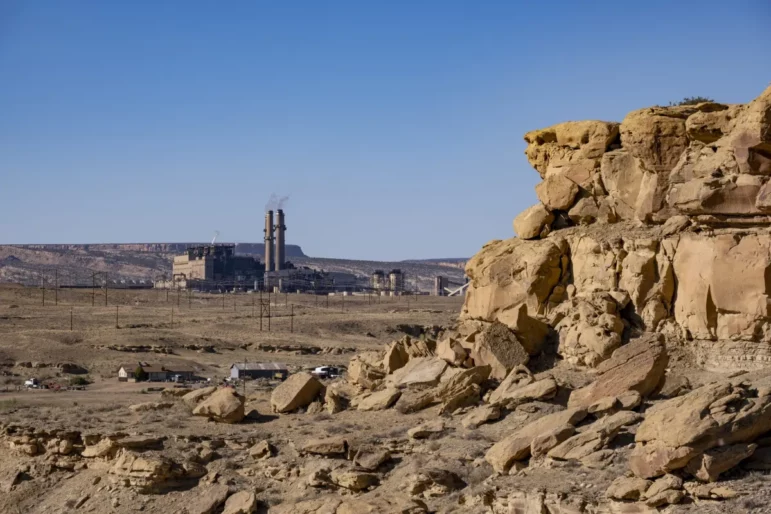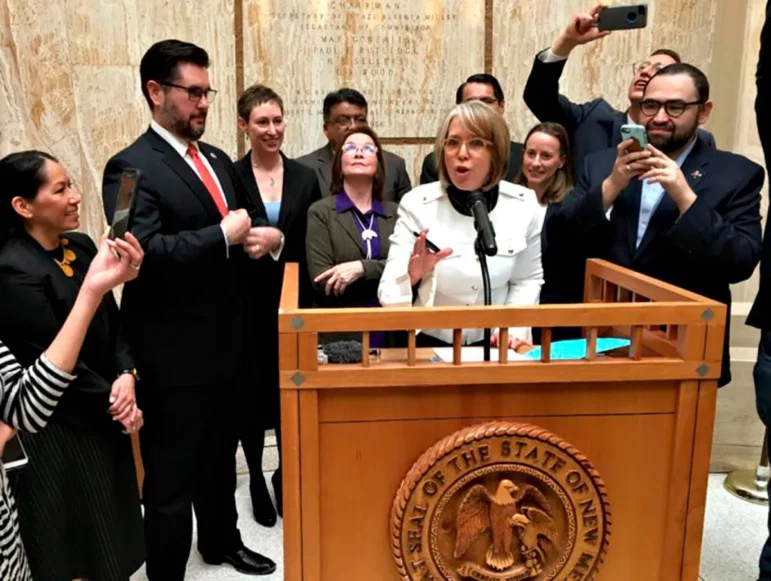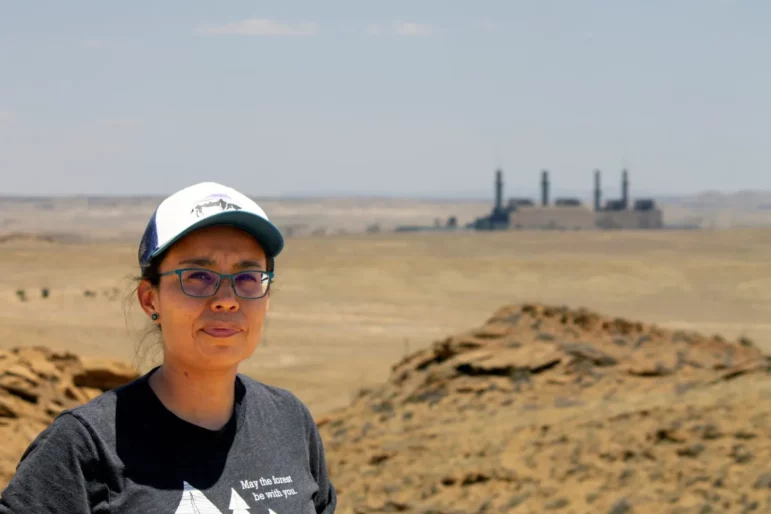
New Mexico was on track to become a model for phasing out coal power without abandoning those who have worked, lived, or breathed under its smokestacks.
The state’s largest utility had already announced plans to divest from coal. A new state law would hold it to that pledge while also providing millions of dollars in funding for workers and affected communities.
“This is a really big deal,” Gov. Michelle Lujan Grisham said at the bill signing. “The Energy Transition Act fundamentally changes the dynamic in New Mexico.”
The 2019 law has withstood political and legal challenges, but three years later it still faces a major test. Ongoing drought, supply chain issues, and rising natural gas prices threaten to complicate or delay its rollout by prolonging the life of the state’s largest and most polluting coal-fired power plant.
Advocates for a so-called just transition from fossil fuels are confident the legislation will eventually achieve its goals, but they may still face months or years more uncertainty about its timeline and implementation.
Early momentum
Lujan Grisham was elected in 2018 as part of a cohort of “Green New Deal” Democrats across the country. As soon as her term began, she and fellow Democrats in the statehouse, with the backing of state and regional environmental groups, set out to craft a sort of miniature Green New Deal, reviving legislation that previously had perished.
Momentum was on their side. The state’s largest utility, Public Service Company of New Mexico, known as PNM, had already said in 2017 that it was washing its hands of coal power and would close down its San Juan Generating Station in June 2022. Soon thereafter, Arizona Public Service indicated it would shut down the Four Corners Power Plant, just eight miles from the San Juan plant, in 2031.
The two facilities — originally having a combined nameplate capacity of more than 3,000 megawatts — were among half a dozen large coal plants built on the relatively sparsely populated Colorado Plateau during the 1960s and ‘70s to quench burgeoning hunger for electricity in the Southwest. The smokestacks have spewed thousands of tons of harmful particulates, including the potent neurotoxin mercury, into nearby, predominantly Navajo, communities, while shipping nearly all of the power to far-off cities.
The Energy Transition Act aims to address both the pollution and injustice. The law mandates that New Mexico electricity providers get 80% of their power from renewable sources by 2040, and 100% from carbon-free sources by 2045 — ambitious goals for a state that currently gets half its electricity from coal and a third from natural gas.

It allows a utility to take out “energy transition bonds” to cover costs associated with coal plant abandonment. That includes up to $30 million for coal mine reclamation, and up to $40 million to help displaced workers and affected communities, to be shared by the Energy Transition Indian Affairs Fund, Economic Development Assistance Fund and Displaced Worker Assistance Fund.
While the funds don’t match the estimated $100 million or more in economic impact from the closure, “it’s a good first step and gives us something for the Four Corners communities to build on,” said Robyn Jackson, interim executive director of Diné CARE, an environmental group that has held the plants’ owners to account for four decades.
Farmington’s Republican state lawmakers, Rep. Rod Montoya and Sen. William Sharer, ardently worked to kill the bill, transition funds and all. Before its passage, they tried to require PNM to keep running the San Juan plant five years longer than planned. And, in concert with fossil fuel advocacy groups such as Power the Future, a national group calling itself “the voice of energy workers advocating for their jobs and communities, and pushing back on the radical environmental movement,” they have continued to attack it ever since, even though the act was a reaction to the plant’s closure, not its cause. In February, Montoya co-sponsored a bill that would have extended the life of the San Juan plant and included natural gas plants under state clean power sources. It didn’t pass.
Opposition has also come from an unexpected place: New Energy Economy, a Santa Fe clean energy group that has also been PNM’s most outspoken adversary on a number of issues. New Energy has said it supports the mandates to decarbonize but it is not keen on the fact that PNM’s ratepayers, not shareholders, ultimately would pay for the abandonment and just transition funds through the bonds. It argued in a 2019 court challenge that the act unconstitutionally took away state regulators’ oversight of monopoly electric utilities.
In January, New Mexico’s Supreme Court rejected New Energy’s challenge and affirmed the Public Regulation Commission’s decisions regarding abandonment and securitization. The ruling ended the legal battle over the act and cleared the way for the closure of the coal plant and the transition to clean energy.

Coal plant’s revival
But several factors have collided over the last year that could complicate and delay — perhaps for years — the transition from fossil fuels.
The summer of 2021 was brutally hot and dry across the West, dealing a one-two punch to the power grid as drought depleted hydropower supplies and the heat increased electricity demand. With a high likelihood of a repeat this year, and with solar projects delayed by a federal probe into Asian solar imports and pandemic-related supply chain constraints, PNM opted to keep one of two San Juan plant units running through September, three months past the scheduled retirement date.
Meanwhile, a virtually unknown company emerged to buy the power plants with plans to install carbon capture equipment. Enchant Energy now has more time to get its regulatory ducks in a row and to sell power from the plant — which has become more cost-competitive due to high natural gas prices. Enchant’s plant takeover is anything but a done deal, but if it were to transpire, and the plant were to continue running, it could affect the implementation of the Energy Transition Act.

This article is one in a series published in late June by the Energy News Network and co-published by High Country News. Reporter Jonathan Thompson found New Mexico’s efforts to transition to a clean energy economy in the state’s northwest won’t be easy as companies make a play to keep tapping natural gas and coal through carbon capture and sequestration and a new hydrogen fuel sector. New Mexico In Depth is republishing the three-part series because global efforts to move away from fossil fuels to clean energy sources will be central to New Mexico’s economy over the coming decades.
Articles:
Will carbon capture help clean New Mexico’s power, or delay its transition?
In San Juan Basin, cultural, economic bonds slow fossil fuel transition
New Mexico’s coal transition law still faces an uncertain timeline
Enchant Energy CEO Cindy Crane said keeping the plant open would preserve high-wage jobs at the plant and mine, about 40% of which are held by Navajo workers, while also adding hundreds of union construction jobs to build the carbon capture equipment. It also would give local officials more time to prepare for the demise of the coal industry and the economic transition it necessitates.
PNM says it will abandon the plant later this year, regardless of what happens with Enchant, and will then pay the transition funds to the state. But delivery of a portion of those funds to the affected communities could be delayed by inconsistent language in the act, said Cydney Beadles, New Mexico clean energy program manager for Western Resource Advocates, who previously was the legal division director at the New Mexico Public Regulation Commission.
The act treats “close” and “abandon” synonymously, indicating that the authors did not account for a scenario in which the plant continued to run after abandonment. The act does not specify how the funds are distributed if the plant continues operations and workers are not displaced after PNM’s abandonment, meaning the legislature probably would have to step in and decide.
Meanwhile, PNM also was making a move that could extend the life of the Four Corners Power Plant beyond Arizona Public Service’s 2031 exit. It proposed not just to divest from the plant, but to pay the tribe-owned Navajo Transitional Energy Company $75 million for it to take over PNM’s 13% share. Helmed by coal industry veterans, the company owns a trio of huge coal mines in the Powder River Basin.
More significantly, in 2013 it purchased the Navajo Mine, which feeds the Four Corners plant, meaning the company “has a self-serving interest to keep the plant running as long as possible,” according to Tó Nizhóní Ání’s Nicole Horseherder, the leader of the effort to get a just transition at the Navajo Generating Station. “And the longer that coal-generated capacity is part of the energy mix, the longer the delay in producing the economic benefits of transitioning to low-cost renewable energy.”
Even more egregious to the environmental community was that PNM proposed paying for its abandonment of Four Corners with Energy Transition Act bonds, even though it would be transferring its ownership. In other words, the utility wanted to delay or even derail its transition from coal using a law intended to expedite that same transition. State regulators rejected PNM’s proposal in December, but the utility has appealed.
Meanwhile, a proposal to a committee vetting funding requests for the just transition funds could divert money back toward the fossil fuel industry.
The “consolidated proposal” by San Juan College includes pitches for a solar charging station manufacturing facility, a pumped hydropower energy storage facility, a medical waste incinerator and a retail business park in the Navajo community of Shiprock. But it also includes proposals to produce hydrogen using the area’s abundant natural gas. And a plan for a “green certification” program that would train students to be able to offer third-party green certification to oil and gas companies. While the end goal is to make oil and gas production less carbon-intensive, this sort of certification is also a form of greenwashing, according to many environmentalists, that perpetuates the fossil fuel economy.
San Juan College’s partner in this endeavor is Western States and Tribal Nations, an organization dedicated to opening up foreign markets to natural gas from the Interior West by supporting the construction of an LNG export terminal in Mexico. The organization’s chairperson is Jason Sandel, the executive vice president of Aztec Well, a family-owned oilfield services company based in the San Juan Basin and a big hydrogen hub booster. He also helms the Energy Transition Act advisory committee, meaning he’ll be involved in vetting the proposals for funding.
Members of the environmental community say the Energy Transition Act has proven durable and will continue to do what it was meant to do as the coal economy fades.
“Coal is dying because it’s expensive and dangerous, and renewables are cheap and safe, and they are what we need to prevent the unthinkable,” said Camilla Feibelman, director of the Sierra Club’s Rio Grande chapter. “A changing economy, the impacts locally of polluting industries, and the global impacts of climate change are profoundly difficult for everyone involved, but if we work together as an integrated community to find solutions we may get there.”